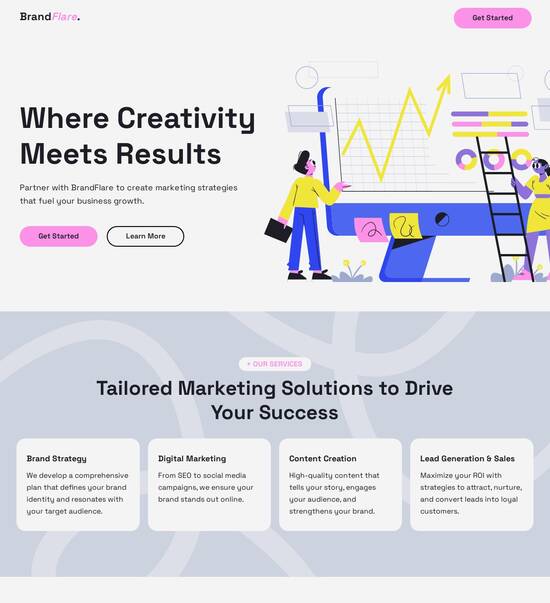
React.js optimized marketing campaign page template
Explore Similar TemplatesAbout template
Supercharge your marketing campaign page with React.js for outstanding performance! Learn more today.
Recommended templates

Easy to build without coding
With the intuitive drag-and-drop builder, anyone on your team can create high-converting pages without any knowledge of code or design. Make enhancements to your landing page with custom widgets using Javascript, HTML/CSS, or third-party scripts.

Multiple layouts for any industry and goal
Select from 500+ landing page layouts built to boost conversions across industry-specific scenarios. Customize them by adjusting fonts, adding images, and generating on-brand content with the AI assistant. Quickly scale with Instablocks® and Global Blocks that you can save, reuse, and update globally.

Loads fast and looks polished on any device
Every template is responsive, which means they present professionally on any device and load blazingly fast with our Thor Render Engine. You can also power them up with Google AMP technology to deliver an unparalleled mobile experience and drive higher conversions.

Robust analytics & experimentation
Get real-time updates and reporting across all your devices, showing the number of visitors, conversions, cost-per-visitor, and cost-per-lead. Launch AI-powered experiments, run A/B tests, and use heatmaps to analyze user behavior, then optimize your landing page to maximize conversions.







Easy to build without coding
With the intuitive drag-and-drop builder, anyone on your team can create high-converting pages without any knowledge of code or design. Make enhancements to your landing page with custom widgets using Javascript, HTML/CSS, or third-party scripts.
Multiple layouts for any industry and goal
Select from 500+ landing page layouts built to boost conversions across industry-specific scenarios. Customize them by adjusting fonts, adding images, and generating on-brand content with the AI assistant. Quickly scale with Instablocks® and Global Blocks that you can save, reuse, and update globally.
Loads fast and looks polished on any device
Every template is responsive, which means they present professionally on any device and load blazingly fast with our Thor Render Engine.
Robust analytics & experimentation
Get real-time updates and reporting across all your devices, showing the number of visitors, conversions, cost-per-visitor, and cost-per-lead. Launch AI-powered experiments, run A/B tests, and use heatmaps to analyze user behavior, then optimize your landing page to maximize conversions.
All the features you need to build lead-generating landing pages
Explore more featuresLearn how to build top-performing landing pages for any goal
FAQs
Leading the way in building high-performing landing pages





Unlocking the power of Instapage for your marketing campaigns
Instapage's landing page and CRO platform is the ultimate solution for marketers in the USA aiming to enhance their digital marketing campaigns. With an array of tools designed to accelerate conversion rates and maximize ROI, Instapage offers a robust environment to optimize your campaigns efficiently. This guide provides a step-by-step approach to harnessing the full potential of Instapage, ensuring a seamless integration into your marketing strategies.
Why choose Instapage for landing page creation?
Instapage stands out as a leading choice for creating effective landing pages due to its user-friendly interface and extensive features. Here are some reasons why marketers are choosing Instapage:
- Comprehensive templates: Over 100 high-converting templates available to kickstart your campaigns instantly.
- Customization flexibility: Tools that allow marketers to tailor landing pages without any coding knowledge.
- Conversion optimization tools: Access to heatmaps and A/B testing features to analyze user engagement and make data-driven improvements.
Step 1: Create a landing page with ready-to-use templates
To start, leveraging Instapage's library to create your landing page can save time and enhance efficiency. The platform offers high-quality templates that align with various marketing strategies. Here's how to proceed:
- Explore the template library: Visit the templates section and browse through options tailored for your industry and goals.
- Select and customize: Choose a template that resonates with your campaign objectives and customize it using the drag-and-drop builder.
- Publish and share: Once satisfied with your design, publish your landing page and share it across your marketing channels.
Step 2: Optimize your landing page for conversions
Effective conversion optimization is crucial for maximizing ROI. With Instapage's built-in features, you can fine-tune your landing page to improve user engagement. Follow these steps:
- Implement A/B testing: Utilize the A/B testing tool to compare variations of your landing page and identify which performs best.
- Analyze user behavior: Use heatmaps to gather insights on how visitors interact with your page, focusing on which elements drive conversions.
- Adjust based on analytics: Regularly review your analytics dashboard to keep track of performance metrics and adjust strategies accordingly.
Step 3: Collaborate with your marketing team
Teamwork is essential in a marketing environment, and Instapage enhances collaboration through real-time editing and feedback features. Here's how to make the most of these tools:
- Enable real-time collaboration: Add team members to your project to brainstorm ideas and suggest changes immediately.
- Share securely: Use secure links to share your landing pages with external stakeholders for feedback.
- Gather and implement feedback: Have clear channels for team members to provide feedback, ensuring it’s incorporated into the final design.
By utilizing these steps, marketers can effectively leverage Instapage to create, optimize, and collaborate for a successful campaign.
Start maximizing your marketing campaigns today with Instapage! Explore our platform and see how easy it is to drive results that matter.
The evolution of landing pages: A ReactJS approach to marketing campaigns
The significance of landing pages in digital marketing
Landing pages play a crucial role in conversion rates for digital marketing campaigns. Unlike regular webpages that offer extensive information about a brand or product, landing pages are designed specifically to drive actions. They guide visitors toward a single objective, typically a conversion goal such as signing up for a newsletter or making a purchase. Their focus on reducing distractions and enhancing user experience directly correlates with higher conversion rates.
Marketers often face challenges with traditional landing page setups. Common issues include cluttered designs that overwhelm visitors, poor load times, and a lack of responsiveness across different devices. These problems can lead to a higher bounce rate, where potential customers leave before engaging with the content or taking desired actions. This is where adopting an advanced approach using technologies like ReactJS can significantly improve the performance and usability of landing pages.
Exploring ReactJS: The framework transforming web experiences
ReactJS has gained immense popularity since its inception by Facebook in 2013. As a JavaScript library focused on building user interfaces, it provides developers with the tools needed to create seamless web experiences. React's rise can be attributed to its component-based architecture and efficient renderings, which have markedly changed the landscape of web development.
Component-based architecture for reusability: This allows developers to create isolated components that can be reused throughout the application, leading to faster development and easier maintenance.
Virtual DOM for optimized performance: React uses a virtual representation of the DOM to minimize direct interactions, resulting in faster rendering and higher performance.
Declarative code for improved readability: Developers can write code that is easier to read, making it more straightforward to understand data flow and manage user interactions.
Crafting the perfect marketing campaign page template with ReactJS
Creating an effective marketing campaign page template with ReactJS involves careful consideration of structure and design. A well-structured landing page must feature key elements to achieve its goals. These include attention-grabbing headlines that draw visitors in, engaging subheadings that complement the main message, and impressive visuals that keep the audience interested. Furthermore, clear and concise call-to-action (CTA) buttons are essential for guiding user actions.
Attention-grabbing headlines: Craft compelling and relevant headlines that resonate with your target audience.
Engaging subheadings: Use subheadings strategically to provide context and reinforce your primary message.
Impressive visuals: Integrate high-quality images or videos that support your content and enhance user engagement.
Clear call-to-action buttons: Ensure that CTAs stand out and are positioned prominently to facilitate easy access.
Customization is critical, enabling administrators to adjust elements based on their brand's voice or specific demographic needs. With React, developers can create templates that cater to different marketing goals, whether that’s promoting a product, collecting leads, or driving event registrations.
The architecture of a ReactJS landing page template
Understanding the layout and design principles in ReactJS is vital for crafting an effective landing page template. Flexibility in webpage layout is one of React's strong suits, complemented by CSS-in-JS libraries that allow for dynamic styling. Moreover, utilizing Grid and Flexbox configurations ensures that landing pages are responsive and look appealing on various devices.
Flexibility in webpage layout with CSS-in-JS libraries: This approach lets developers write styled components in JavaScript, streamlining the process of creating tailored styles.
Grid and Flexbox configurations: These CSS layouts provide the structure needed to ensure pages are responsive and attractively arranged across device types.
In terms of component hierarchy, landing page templates benefit from distinguishing between presentational and container components. Presentational components are responsible for how things look, while container components manage the application's logic and state. This separation allows for cleaner code and improved maintainability, ultimately enhancing the user experience.
Advanced features of ReactJS landing page templates
One of the key advantages of using ReactJS for landing page templates is the ability to enhance user experiences with interactive components. By leveraging stateful components, developers can create engaging features such as modal windows, accordions, or interactive forms that require user interaction. These elements not only keep visitors engaged but also encourage them to explore the page further.
Modal windows: These pop-ups can display additional information without navigating away from the current page.
Accordions: Expandable sections that reveal more content can improve readability and user engagement.
Interactive forms: Forms that provide feedback or animations based on user inputs can significantly enhance interactivity.
Integrating user feedback loops directly into the page is another compelling feature. ReactJS makes it straightforward to collect data through forms and analyze visitor behavior, helping marketers make informed decisions based on actual user interactions.
Performance optimization strategies for landing pages
Performance is paramount when it comes to landing pages; slower sites can lead to higher bounce rates and lost conversion opportunities. ReactJS provides several techniques to optimize load times and improve the overall responsiveness of landing pages. This includes code-splitting, which allows for loading only the necessary parts of a page at a time, helping to improve load times.
Code-splitting: This technique allows developers to break their code into smaller chunks, loading only what is needed for the current user view.
Lazy loading: Images and other resources can be set to load only when they enter the viewport, reducing initial load times.
Using memoization: React's memoization can prevent unnecessary renders by optimizing component updates based on user interactions.
Additionally, following best practices for optimizing images and assets can make a significant difference in performance. Compression techniques and serving images in modern formats can greatly reduce loading times, ultimately leading to better user experiences and improved conversion rates.
Transformative benefits of a ReactJS landing page template
Using a ReactJS landing page template can streamline marketing efforts through efficient workflows. One major benefit is the use of reusable components that can significantly speed up the design and development process. Instead of building unique components from scratch for each new campaign, teams can leverage existing designs, facilitating quicker turnaround times.
Reusable components: These speed up development and allow teams to maintain design consistency across campaigns.
Facilitating collaboration: With clear structures, designers and developers can work together more effectively, ensuring the end product aligns with marketing goals.
Version control for seamless updates: Developers can easily manage updates and troubleshooting through version control systems, minimizing risks.
By leveraging these benefits, businesses can boost conversion rates and visitor engagement. Real-world examples abound of companies successfully utilizing ReactJS templates to drive higher conversion rates through improved user experiences and targeted functionalities.
Resources for implementing ReactJS landing page templates
Selecting the right tools and libraries is critical when building landing pages using ReactJS. Various React libraries can aid in the development process, such as React-Router for creating seamless navigation experiences. Additionally, styled-components provide a powerful way to manage component styles without the limitations of traditional CSS.
React-Router: Essential for managing navigation and routes in application.
Styled-components: A library that enables authoring CSS directly in JavaScript, enhancing flexibility.
Boilerplates and starter kits: Utilizing these resources can significantly reduce the initial setup time for projects.
For marketers and developers looking to improve their skills, engaging with online courses and tutorials specifically designed for creating ReactJS templates can prove invaluable. Additionally, becoming active in developer communities provides opportunities for learning best practices and gaining support during troubleshooting.
Future trends in landing page development
Keeping an eye on future trends is essential for marketers looking to stay ahead of the competition. The integration of AI and machine learning is set to impact user interactions on landing pages significantly. Predictive algorithms will allow for the customization of content based on user behavior, potentially increasing engagement and conversions.
Predictive algorithms: These can analyze user data to tailor content, making landing pages more relevant.
Automated A/B testing: AI can facilitate systematic testing, providing insights to optimize page elements.
Additionally, Progressive Web Apps (PWAs) are creating new standards for landing pages, enhancing the user experience with fast-loading and responsive designs. The convergence of landing pages and app-like experiences will result in improving overall functionality and engagement.
Final thoughts on optimizing marketing campaigns with ReactJS
In conclusion, ReactJS is redefining how we approach landing page development. By addressing performance, user experience, and design flexibility, it empowers marketers to create highly effective campaign pages. The unique capabilities of React for building optimized templates enable a seamless flow from user interaction to conversion, ultimately influencing brand trust and customer loyalty.
As marketers continue to explore the intricacies of digital experiences, technologies like ReactJS will provide valuable tools for innovation. It's an exciting time to embrace these advancements and explore new horizons in digital marketing.
Ready to skyrocket conversions?
Supercharge your ad campaigns with high-performing landing pages
Get started














